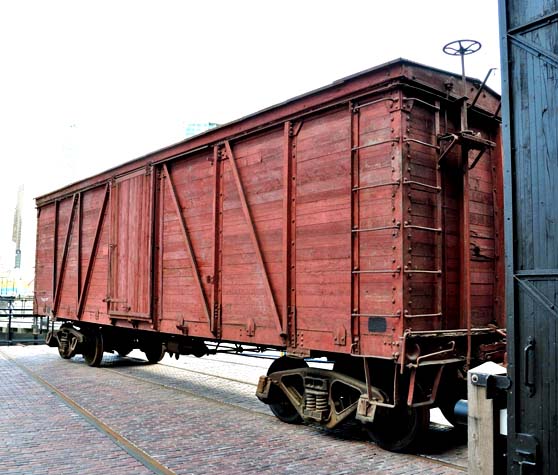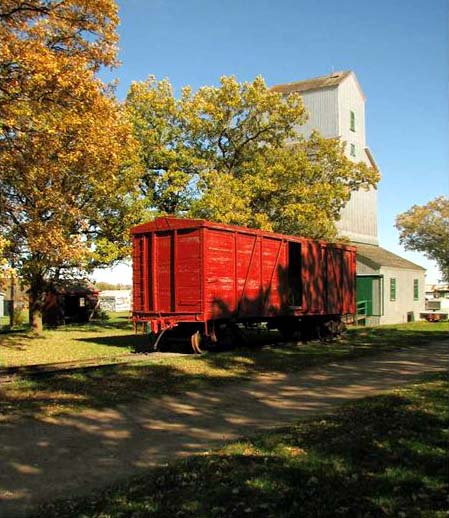
5 March 2011
CPR Boxcar 119462

|
Canadian Pacfic Railway Fowler boxcar number 188625 at the Toronto Historical Railway
Association's John Steet Roundhouse. |

Austin Manitoba - From time to time, the Manitoba Agricultural Museum is asked why the museum
has some railway artifacts including a boxcar.
The museum's reply is that Manitoba produces far more agricultural commodities than the citizens of this province can consume.
Manitoba agriculture depends upon exports and the scarred and battered boxcar resting on the museum track is one of the few surviving cars of a design that
served as the backbone of the Canadian Pacific's and Canadian National's grain hauling fleets.

Canadian Pacific Railway boxcar 119462 at the Manitoba Agricultural Museum in Austin,
Manitoba - Date unknown Manitoba Agricultural Museum.
|
From 1909 onwards, with the last of this design finally being retired in the late 1970s, this design is often
referred to as a Fowler boxcar as one of the designers was named Fowler.
There are no markings on the outside of the museum car to display which railway donated it. But an examination of the interior reveals the car to be the
Canadian Pacific Railway's Boxcar 119462.
119462 was built in 1914 as part of an order of 3,000 Fowler boxcars placed by the CPR with the Canadian Car and Foundry Company.
The CPR owned a total of 33,000 Fowler boxcars built between 1909 and 1915. The CNR owned another 33,000 Fowler boxcars and Fowlers were also built for US
railroads.
The CPR in 1900 was struggling with a traffic boom resulting from the opening of the west and the tremendous demand for prairie wheat. As well, the CPR enjoyed
good traffic from the Europe-Asia trade as it was the only railway completely crossing North America from coast to coast at the time. The result was the CPR's
boxcar fleet was pressed to the limit. Thousands of cars were needed.
At this time, boxcars and other railway cars were predominantly wood, but the need for new car designs employing steel was becoming apparent. Knuckle couplers,
air brakes, and more powerful locomotives resulted in longer, heavier, faster, trains being operated and wooden cars began to experience structural failure due
to the stresses generated. A major effort to design new cars employing steel was justified.
In 1908, the Dominion Car and Foundry Company produced three experimental cars. The third car became the design of choice for the Canadian Pacific and large
scale manufacture began in 1909.
This design, which became known as the Fowler boxcar, had a steel frame and structure made up of Z-shaped and flat bar steel pieces hot riveted together.
Once the frame was assembled, wood was bolted on to complete the floor, sides, and roof.
The stresses thrown on a car in train operation were completely borne by the steel frame with the wooden parts bearing no stresses from train operation.
The Fowler design was as attractive as it was cheap and easy to build and repair, had a low tare or empty weight, and the design resulted in a tight joint
between sides and floors which was necessary in hauling grain.
As well, the wood sheathing was applied on the inside of the steel frame which made cleaning the car easy and reduced damage to manufactured goods being hauled
in the car.
As the design used Z-shape and flat steel bars with no specialized castings, problems in making repairs to these cars by other railways was reduced. This was a
major issue as cars roamed North America and if a car was damaged away from their home road, repairs had to be made before moving the car.
Wooden cars were no problem as the skills and materials existed to duplicate damaged parts. Replacing a specialized casting or steel shape was a far more
difficult task.
The Fowler cars were not large by today's standards, with a 36 foot inside length (inside the car), 8 foot 6 inches inside width, and an 8 foot inside height
resulting in a 2,450 cubic foot capacity.
The loaded weight of the car design was 80,000 pounds with a tare weight of 38,300 pounds. The first cars built had wooden roofs and doors, but later cars had
stamped steel roofs and corrugated steel doors.
Cars were often rebuilt so early cars could appear with steel roofs and doors or any combination thereof.
The Fowler boxcars could easily be converted to stock cars by removing every second board of the sheathing and installing slatted doors.
In grain service, the Fowler cars or any boxcar needed to be "coopered". This meant planks had to be fastened across the door openings to take the
weight of the grain.
The planks did not go all the way to the top of the opening so as to allow the elevator grain pipe to be inserted into the car and loading to begin. Sometime
in the late 1950's the planks were replaced by heavy cardboard sheets reinforced with steel strapping.
When unloading, the planks or cardboard sheets were pushed in so the grain could run out. Power scoop shovels were used at one point to unload cars until car
dumpers were developed.
Individual cars were pushed onto the dumper, secured to it, the planks pushed in and removed, then first one end of the car was elevated and then the other,
all while the car was rolled over to one side. In short, the grain was poured out of the boxcar.
No records were kept of the movements of individual boxcars beyond what was needed to bill customers at the moment, so we have no exact idea what 119462 did
between 1914 and 1977, when the car was donated to the museum by the CPR.
This class of car made up the backbone of the CPR's grain hauling fleet through to the 1950's.
The Fowlers began leaving service in large numbers in the 1950s but a few made it to the late 1970s hauling grain when all were finally retired.
Looking at the interior of the 119462, it is in good shape yet, and the sheathing around the doors bears the marks of grain planks being nailed into place.
Doubtlessly, 119462 is a veteran of many a fall grain "rush" with countless trips to the Lake Head, the Pacific, Montreal, and into the US while
hauling grain to its credit.
119462 has earned its place at the Manitoba Agricultural Museum and is a interesting part of the story of agriculture the Manitoba Agricultural Museum seeks to
preserve and tell to current and future generations.
Alex Campbell.

|